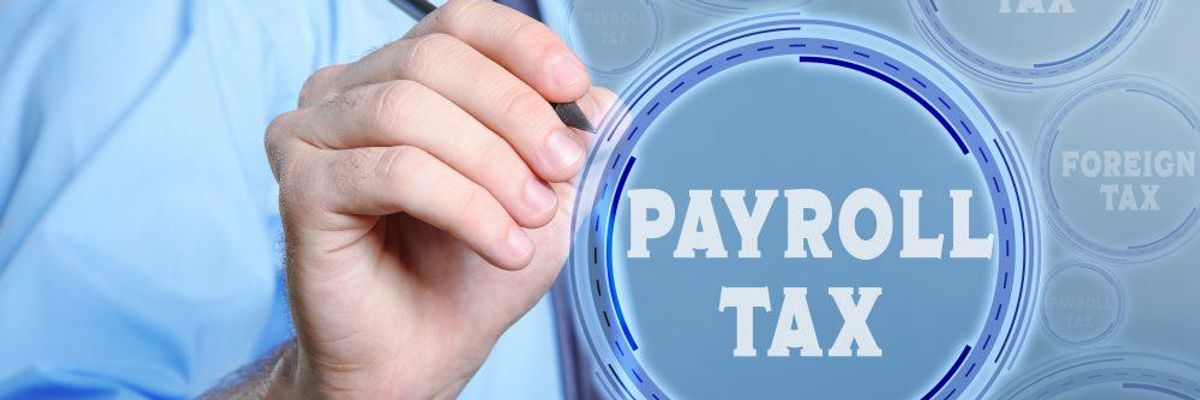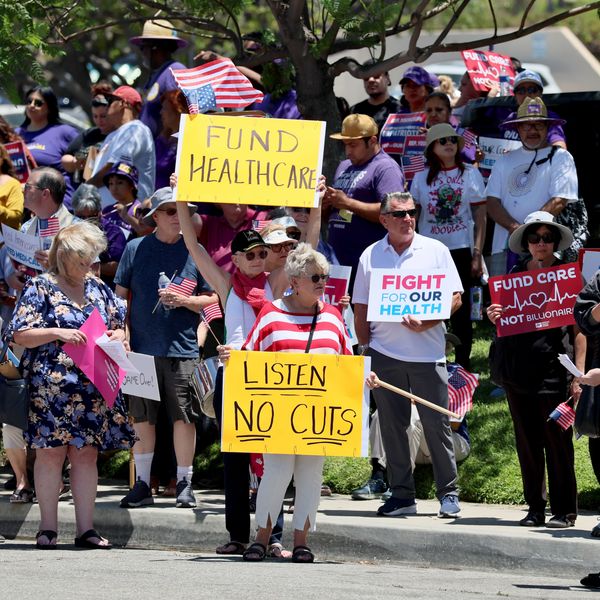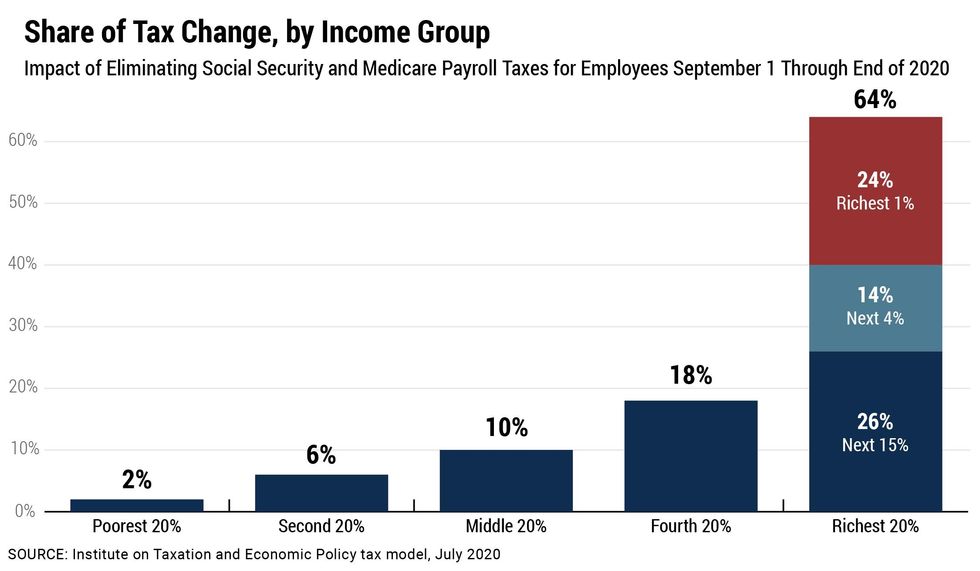
ITEP's analysis assumes that Trump's proposal would suspend both the employee and employer sides of payroll taxes. (Photo: CC)
Trump's Payroll Tax Holiday Would Mostly Benefit the Rich While Sabotaging Medicare and Social Security
Let’s be clear about what the President is suggesting–cutting benefits for the unemployed while nominally giving a tax cut to those with jobs, and steering the ultimate benefits to wealthy business owners and shareholders.
More than 30 million Americans are currently not working. The unemployment rate is above 11 percent even after some rehiring in late spring. There is no end in sight to the deadly pandemic. State and local governments face collapsing revenue and may push the unemployment rate still higher by laying off workers. The President is, by all reports, ready to allow unemployment benefits to drop precipitously and to allow layoffs of public employees. Instead of helping the jobless, the President proposes a payroll tax break for those who have jobs.
While the White House hasn't clarified what it is proposing, we know that a payroll tax cut would not be well-targeted. In a new report, ITEP estimates the effects of suspending Social Security and Medicare payroll taxes for employees and employers from 1 through the end of the year. We find that 64 percent of the benefits would go to the richest 20 percent of Americans while 24 percent of the benefits would go to the richest 1 percent.
Social Security is funded by a tax of 12.4 percent of earned income up to a maximum of $137,700 for 2020. Employees pay half (6.2 percent) and employers pay the other half. Medicare is funded by a tax of 2.9 percent on earnings with no maximum, also evenly split between employers and employees.
ITEP's analysis assumes that Trump's proposal would suspend both the employee and employer sides of payroll taxes. The break for employers particularly rewards the rich, who own most businesses. Because the break on payroll taxes would be in effect only for a few months, it is unlikely that workers would be able to successfully compel employers to pass the tax savings onto them. The break on employer payroll taxes would simply be a windfall to businesses and, ultimately, those who own them.
Let's be clear about what the President is suggesting-cutting benefits for the unemployed while nominally giving a tax cut to those with jobs, and steering the ultimate benefits to wealthy business owners and shareholders.
An Urgent Message From Our Co-Founder
Dear Common Dreams reader, The U.S. is on a fast track to authoritarianism like nothing I've ever seen. Meanwhile, corporate news outlets are utterly capitulating to Trump, twisting their coverage to avoid drawing his ire while lining up to stuff cash in his pockets. That's why I believe that Common Dreams is doing the best and most consequential reporting that we've ever done. Our small but mighty team is a progressive reporting powerhouse, covering the news every day that the corporate media never will. Our mission has always been simple: To inform. To inspire. And to ignite change for the common good. Now here's the key piece that I want all our readers to understand: None of this would be possible without your financial support. That's not just some fundraising cliche. It's the absolute and literal truth. We don't accept corporate advertising and never will. We don't have a paywall because we don't think people should be blocked from critical news based on their ability to pay. Everything we do is funded by the donations of readers like you. Will you donate now to help power the nonprofit, independent reporting of Common Dreams? Thank you for being a vital member of our community. Together, we can keep independent journalism alive when it’s needed most. - Craig Brown, Co-founder |
More than 30 million Americans are currently not working. The unemployment rate is above 11 percent even after some rehiring in late spring. There is no end in sight to the deadly pandemic. State and local governments face collapsing revenue and may push the unemployment rate still higher by laying off workers. The President is, by all reports, ready to allow unemployment benefits to drop precipitously and to allow layoffs of public employees. Instead of helping the jobless, the President proposes a payroll tax break for those who have jobs.
While the White House hasn't clarified what it is proposing, we know that a payroll tax cut would not be well-targeted. In a new report, ITEP estimates the effects of suspending Social Security and Medicare payroll taxes for employees and employers from 1 through the end of the year. We find that 64 percent of the benefits would go to the richest 20 percent of Americans while 24 percent of the benefits would go to the richest 1 percent.
Social Security is funded by a tax of 12.4 percent of earned income up to a maximum of $137,700 for 2020. Employees pay half (6.2 percent) and employers pay the other half. Medicare is funded by a tax of 2.9 percent on earnings with no maximum, also evenly split between employers and employees.
ITEP's analysis assumes that Trump's proposal would suspend both the employee and employer sides of payroll taxes. The break for employers particularly rewards the rich, who own most businesses. Because the break on payroll taxes would be in effect only for a few months, it is unlikely that workers would be able to successfully compel employers to pass the tax savings onto them. The break on employer payroll taxes would simply be a windfall to businesses and, ultimately, those who own them.
Let's be clear about what the President is suggesting-cutting benefits for the unemployed while nominally giving a tax cut to those with jobs, and steering the ultimate benefits to wealthy business owners and shareholders.
More than 30 million Americans are currently not working. The unemployment rate is above 11 percent even after some rehiring in late spring. There is no end in sight to the deadly pandemic. State and local governments face collapsing revenue and may push the unemployment rate still higher by laying off workers. The President is, by all reports, ready to allow unemployment benefits to drop precipitously and to allow layoffs of public employees. Instead of helping the jobless, the President proposes a payroll tax break for those who have jobs.
While the White House hasn't clarified what it is proposing, we know that a payroll tax cut would not be well-targeted. In a new report, ITEP estimates the effects of suspending Social Security and Medicare payroll taxes for employees and employers from 1 through the end of the year. We find that 64 percent of the benefits would go to the richest 20 percent of Americans while 24 percent of the benefits would go to the richest 1 percent.
Social Security is funded by a tax of 12.4 percent of earned income up to a maximum of $137,700 for 2020. Employees pay half (6.2 percent) and employers pay the other half. Medicare is funded by a tax of 2.9 percent on earnings with no maximum, also evenly split between employers and employees.
ITEP's analysis assumes that Trump's proposal would suspend both the employee and employer sides of payroll taxes. The break for employers particularly rewards the rich, who own most businesses. Because the break on payroll taxes would be in effect only for a few months, it is unlikely that workers would be able to successfully compel employers to pass the tax savings onto them. The break on employer payroll taxes would simply be a windfall to businesses and, ultimately, those who own them.
Let's be clear about what the President is suggesting-cutting benefits for the unemployed while nominally giving a tax cut to those with jobs, and steering the ultimate benefits to wealthy business owners and shareholders.


